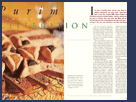

|
||||
| Purim: A Sweet Celebration by Stephanie Gold It's time to buckle down and do your duty for Purim. The biblical commands are very clear: thou shalt party. Way back in the 5th century BCE, Queen Esther and her Uncle Mordecai outwitted wicked Haman, thereby saving the necks of all the Jews in Persia. And what does the Bible tell us to do when the bad guy gets his comeuppance and the good guys (and queens) prosper? Eat a lot, drink a lot, and dress real silly. And that's an order. Of all the Jewish holidays, Purim is the most fun and playful. The Fourteenth of Adar by the Jewish calendar, and late February or early March by western reckoning, this year Purim falls on March 23rd, with the usual spate of parties and Halloween-type costumes, festive goofiness, and the huge Tel Aviv carnival. But you needn't fly to Israel to do justice to Purim. All the ingredients for a frolic of biblical proportions can be found at home. Typical entertainments include a synagogue reading of the story of Purim, and every time Haman's name comes up all the children are encouraged, for a change, to make lots of noise. Groggers (special noise makers just for the occasion) are handed out, and kids (aged 2-95) spend much of the holiday irritating the bezonkers out of everyone within earshot. Some biblical commands call for iron self-control, but Purim instructs you to let loose. The injunction of "Ad'lo'yada" insists you get so schnockered you can't tell the difference between "Blessed is Mordecai" and "Cursed is Haman," and that requires a lot of obligatory imbibing. But while recovering alcoholics, pregnant women, and designated drivers are released from booze duty, plenty of folks attend to the commandment in earnest and guzzle to oblivion, as directed. Purim is not, however, all noise and wine. Food is at the heart and soul of most holidays, and so it is with Purim. With its emphasis on revelry, you know the food is going to be great. "Mishloakh manot" ("sending of portions") is another delightful commandment to fulfill. It requires each Jew to give as a gift a minimum of two ready-to-eat portions of food to friends and family. Sweets are the most popular, and folks send their costumed kids out to deliver; it's a holiday that's generally preceded by weeks of industrious baking. The Purim "se'udah" (meal) is yet one more in a string of not-so-hard-to-comply-with edicts. You're meant to eat a large, festive repast followed by lots of desserts; there aren't many who refuse. Purim rejoices in life and the return of spring, with spring dishes, sweet ingredients, and vegetables. Esther ate vegetarian to keep kosher when she lived with King Ahasuerus (who was not Jewish), so chickpeas have become one traditional Purim repast. Lots of sweet foods mark this holiday, and poppy seed feature in most of them. Cakes and cookies are common, but hamantaschen are the signature pastry, a tasty triangle filled with poppy seeds or fruit. The name is Yiddish for Haman's Pockets, while in Hebrew they're called Oznei Haman (Haman's Ears). Other dishes mock Haman as well. Dutch and Scandinavian Jews bake evil-looking Haman gingerbread, and a Middle Eastern dish of very fine egg noodles tossed with lemon sauce is called Caveos di Aman (Haman's Hair). While Jews from Yemen to Poland celebrate holidays with fine foods, preparation varies dramatically depending on where they developed. Jewish history is full of exile and wandering, and it's resulted in an unusually rich variety of culinary traditions. Ashkenazim (Eastern European Jews) developed a robust cuisine for cold lands, with lots of cheese, eggs, chicken fat, cabbage, beef and poultry, that's traditionally as rich in flavor as in fat. Borsht, chopped liver, knishes, latkes (potato pancakes), blintzes, and gefilte fish - all common Ashkenazi foods - were all most Americans knew of Jewish cooking for a long time. Sephardim (Middle Eastern Jews) are descended from communities that settled in the Near East after the 1492 Spanish Expulsion. Typical Sephardi fare, tangy and well-spiced, includes berekes, lemon sauces, lots of sesame seeds, Turkish coffee with cardamom, and vegetables stuffed with rice and meat and stewed in lemon or tomato sauce. North African and Yemenite Jews are perhaps the oldest Jewish communities in the world. Moroccans would never think of using garlic and onion in the same dish, but they like to enrich rice with saffron (only the very poor substitute turmeric), and use spices like cinnamon, cloves, marjoram, allspice, thyme, and sharp red pepper. Couscous is popular, as are all manner of dried fruit. So here are some recipes from Jewish kitchens around the world, to help you celebrate Purim, observe the coming of spring, and enjoy some good food. |
||||
